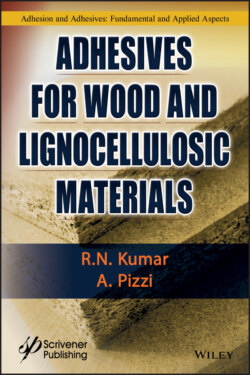Читать книгу Adhesives for Wood and Lignocellulosic Materials - R. N. Kumar - Страница 33
1.7 Wood Factors Affecting Penetration
ОглавлениеThe actual penetration depth of solution or adhesive depends on the permeability of wood to liquids, the technological methods, and physicochemical properties of the specific adhesive. In the case of liquid flow through porous material under ideal conditions with no interactions occurring between the liquid and the porous material, the permeability is defined by Darcy’s law [50]:
where Q is the liquid volume flow [m3 s–1], K is the specific permeability of wood [m2], A is the area perpendicular to the liquid flow [m2], L is the sample length in the direction of flow [m], η is the dynamic viscosity of the liquid [Pa s], and ΔP is the pressure gradient [Pa]. As described by Darcy’s law, the pressure gradient ΔP is the cause for the liquid penetration into wood.
The permeability and surface energy are the two wood-related factors controlling adhesive penetration [44]. Permeability varies with species and direction (e.g., tangential, radial, and longitudinal). However, longitudinal permeability may be as much as 104 times greater than transverse permeability [51]. Wood species with low permeability, such as Douglas-fir heartwood, severely restricts resin penetration in the radial and tangential directions. High permeability of the wood surface may be problematic to adhesive bonding if this leads to starvation at the bondline. Thus, bonding endgrain is difficult [44]. There are earlywood and latewood differences, as well as heartwood and sapwood differences. Pit aspiration sometimes occurs in softwoods during drying [51], thus severely reducing permeability. White [52] noted greater penetration of phenol-resorcinol into earlywood than latewood cells of southern pine.
